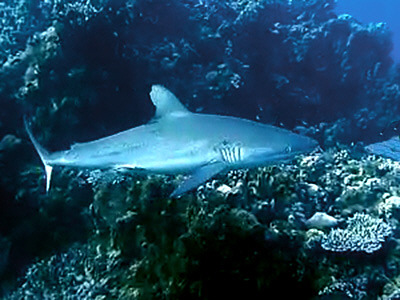 |
Division : SELACHII
Species : more than 500 globally.
Sharks are cartilaginous fishes (division Selachii), closely related to rays
(division Batormorphi). Globally there are more
than 500 species of shark classified into 8 orders and numerous families.
Shark-like fishes first appeared in the Devonian period (419-359 million
years ago), possibly earlier. Their remains are relatively easy to locate in the fossil
record; sharks teeth are constantly shed and replaced, and tend to
accumulate in shallow marine sediments (Fig 4).
The filter-feeding Whale Shark (Rhincodon typus) is the largest of
all shark species, measuring up to 12 metres (Fig 2).
Indonesia supports the world's greatest diversity of sharks, with more than
100 species known to occur in its shallow seas and deep ocean trenches
(Fahmi, 2010). The equatorial location and longitudinal
extent of this huge country, which stretches from the Indian Ocean to the
Pacific Ocean, contributes to this diversity.
In the heart of Indonesia lies the Wallace Line, a significant biogeographical boundary
which separates Bali, Java, Borneo and Sumatra in the west from Lombok,
Sulawesi and islands further east including New Guinea. West of this line the shark fauna is
more akin to that of the Indian Ocean, and to the east of the line is more
akin to western Pacific fauna.
Other countries of Southeast Asia also support high levels of shark
diversity particularly Malaysia and the Philippines.
Over-fishing of sharks, and particularly the abhorrent practice of
shark-finning, continues to decimate populations in the region. This
practice can have serious impacts on the health of coral reefs and other
marine ecosystems. As a result of public pressure the global consumption of
shark-fin soup now appears to be in decline.
Fig 1 : Grey Reef Shark Carcharhinus
amblyrhynchos (Carcharhiniformes : Carcharhinidae). This
fast-moving predator occurs widely in Southeast Asia waters. Photo thanks to Noel Thomas.
Fig 2 : A large Whale Shark Rhincodon typus (Orectolobiformes : Rhincodontidae) in
Western Australia. Photo thanks to Nikki Guy.
Fig 3 : The warm, tropical waters of Indonesia support the greatest shark
diversity in the world. Pictured here are the turbulent waters south of the
island of Java, which drop steeply into a deep ocean trench.
Fig 4 : Fossil sharks' teeth of various species from shallow marine
sediments of the Pliocene epoch (5.3
to 2.6 million years ago). The largest of these measures 4 cm total
length.
References :
Fahmi. (2010). Sharks And Rays In Indonesia. Mar. Res. Indonesia Vol.35,
No.1, 2010: 43-54
Links :
Sharks -
Wikipedia
|